Onur Dizdar
OFDM-RSMA: Robust Transmission under Inter-Carrier Interference
Oct 02, 2023Abstract:Rate-splitting multiple access (RSMA) is a multiple access scheme to mitigate the effects of the multi-user interference (MUI) in multi-antenna systems. In this study, we leverage the interference management capabilities of RSMA to tackle the issue of inter-carrier interference (ICI) in orthogonal frequency division multiplexing (OFDM) waveform. We formulate a sum-rate maximization problem to find the optimal subcarrier and power allocation for downlink transmission in a two-user system using RSMA and OFDM. A weighted minimum mean-square error (WMMSE)-based algorithm is proposed to obtain a solution for the formulated non-convex problem. We show that the marriage of rate-splitting (RS) with OFDM provides complementary strengths to cope with peculiar characteristic of wireless medium and its performance-limiting challenges including inter-symbol interference (ISI), MUI, ICI, and inter-numerology interference (INI). The sum-rate performance of the proposed OFDM-RSMA scheme is numerically compared with that of conventional orthogonal frequency division multiple access (OFDMA) and OFDM-non-orthogonal multiple access (NOMA). It is shown that the proposed OFDM-RSMA outperforms OFDM-NOMA and OFDMA in diverse propagation channel conditions owing to its flexible structure and robust interference management capabilities.
A Proof of Concept for OTFS Resilience in Doubly-Selective Channels by GPU-Enabled Real-Time SDR
Sep 22, 2023Abstract:Orthogonal time frequency space (OTFS) is a modulation technique which is robust against the disruptive effects of doubly-selective channels. In this paper, we perform an experimental study of OTFS by a real-time software defined radio (SDR) setup. Our SDR consists of a Graphical Processing Unit (GPU) for signal processing programmed using Sionna and TensorFlow, and Universal Software Radio Peripheral (USRP) devices for air interface. We implement a low-latency transceiver structure for OTFS and investigate its performance under various Doppler values. By comparing the performance of OTFS with Orthogonal Frequency Division Multiplexing (OFDM), we demonstrate that OTFS is highly robust against the disruptive effects of doubly-selective channels in a real-time experimental setup.
Hybrid Automatic Repeat Request for Downlink Rate-Splitting Multiple Access
Apr 09, 2023Abstract:This work investigates the design of Hybrid Automatic Repeat Request (HARQ) strategies for downlink Rate-Splitting Multiple Access (RSMA). The existence of private and common stream as well as their conditioning for Successive Interference Cancellation (SIC), gives rise to an expanded set of opportunities for retransmission of failed packets. Specifically, we devise a scheme in which the retransmissions are scheduled through the common stream, which offers a higher success probability. With this, the common stream needs to carry both new and retransmitted bits, which leads to a layered HARQ (L-HARQ) strategy which is capable of trading off throughput and reliability. Simulation results demonstrate that the devised HARQ scheme outperforms RSMA with conventional HARQ, where each retransmission is handled independently through its own stream. It also helps in closing the throughput gap between HARQ and Adaptive Modulation and Coding (AMC) in the high SNR regime while also achieving a decreased Packet Error Rate (PER) and a lower latency.
Multicarrier Rate-Splitting Multiple Access: Superiority of OFDM-RSMA over OFDMA and OFDM-NOMA
Mar 25, 2023



Abstract:Rate-splitting multiple access (RSMA) is a multiple access technique generalizing conventional techniques, such as, space-division multiple access (SDMA), non-orthogonal multiple access (NOMA), and physical layer multi-casting, which aims to address multi-user interference (MUI) in multiple-input multiple-output (MIMO) systems. In this study, we leverage the interference management capabilities of RSMA to tackle the issue of inter-carrier interference (ICI) in orthogonal frequency division multiplexing (OFDM) waveform. We formulate a problem to find the optimal subcarrier and power allocation for downlink transmission in a two-user system using RSMA and OFDM and propose a weighted minimum mean-square error (WMMSE)-based algorithm to obtain a solution. The sum-rate performance of the proposed OFDM-RSMA scheme is compared with that of conventional orthogonal frequency division multiple access (OFDMA) and OFDM-NOMA by numerical results. It is shown that the proposed OFDM-RSMA outperforms OFDM-NOMA and OFDMA under ICI in diverse propagation channel conditions owing to its flexible structure and robust interference management capabilities.
Sensing using Coded Communications Signals
Sep 09, 2022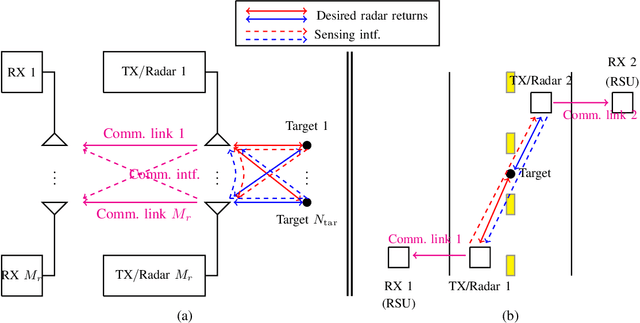


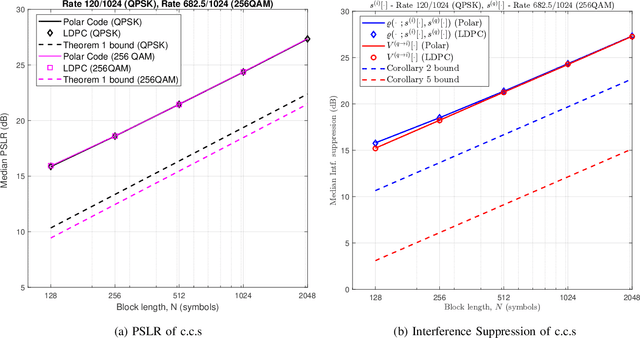
Abstract:A key challenge for a common waveform for Integrated Sensing and Communications (ISAC) - widely seen as an attractive proposition to achieve high performance for both functionalities, while efficiently utilizing available resources -- lies in leveraging information-bearing channel-coded communications signals (c.c.s) for sensing. In this paper, we investigate the sensing performance of c.c.s in (multi-user) interference-limited operation, and show that it is limited by sidelobes in the range-Doppler map, whose form depends on whether the c.c.s modulates a single-carrier or OFDM waveform. While uncoded communications signals -- comprising a block of $N$ i.i.d zero-mean symbols -- give rise to asymptotically (i.e., as $N \rightarrow \infty$) zero sidelobes due to the law of large numbers, it is not obvious that the same holds for c.c.s, as structured channel coding schemes (e.g., linear block codes) induce dependence across codeword symbols. In this paper, we show that c.c.s also give rise to asymptotically zero sidelobes -- for both single-carrier and OFDM waveforms -- by deriving upper bounds for the tail probabilities of the sidelobe magnitudes that decay as $\exp( - O($code rate $\times$ block length$))$. This implies that for any code rate, c.c.s are effective sensing signals that are robust to multi-user interference at sufficiently large block lengths, with negligible difference in performance based on whether they modulate a single-carrier or OFDM waveform. We verify the latter implication through simulations, where we observe the sensing performance (characterized by the detection and false-alarm probabilities) of a QPSK-modulated c.c.s (code rate = 120/1024, block length = 1024 symbols) to match that of a comparable interference-free FMCW waveform even at high interference levels (signal-to-interference ratio of -11dB), for both single-carrier and OFDM waveforms.
Max-Min Fairness of Rate-Splitting Multiple Access with Finite Blocklength Communications
Jul 12, 2022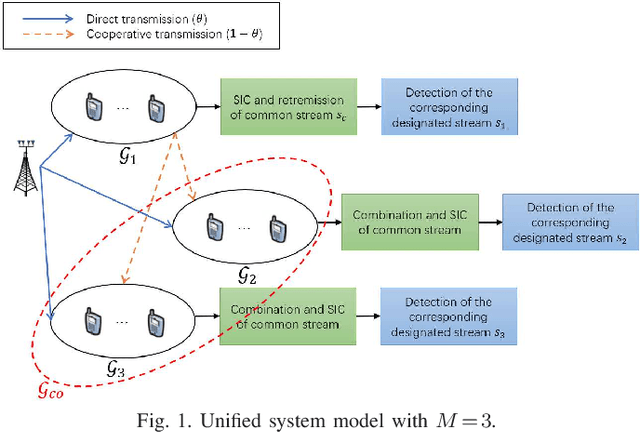
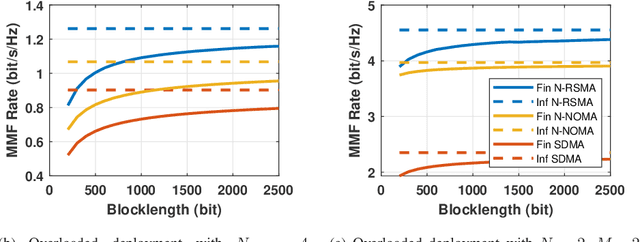
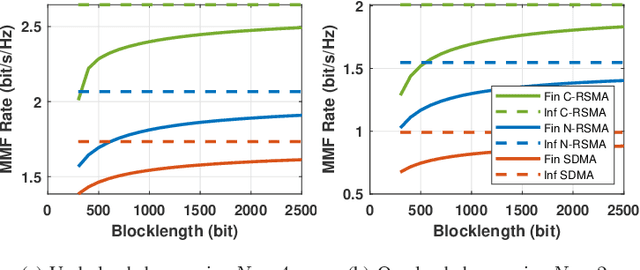
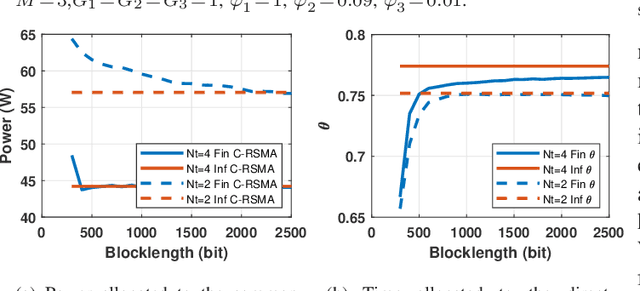
Abstract:Rate-Splitting Multiple Access (RSMA) has emerged as a flexible and powerful framework for wireless networks. In this paper, we investigate the user fairness of downlink multi-antenna RSMA in short-packet communications with/without cooperative (user-relaying) transmission. We design optimal time allocation and linear precoders that maximize the Max-Min Fairness (MMF) rate with Finite Blocklength (FBL) constraints. The relation between the MMF rate and blocklength of RSMA, as well as the impact of cooperative transmission are investigated for a wide range of network loads. Numerical results demonstrate that RSMA can achieve the same MMF rate as Non-Orthogonal Multiple Access (NOMA) and Space Division Multiple Access (SDMA) with smaller blocklengths (and therefore lower latency), especially in cooperative transmission deployment. Hence, we conclude that RSMA is a promising multiple access for guaranteeing user fairness in low-latency communications.
Rate-Splitting Multiple Access for 6G -- Part I: Principles, Applications and Future Works
May 05, 2022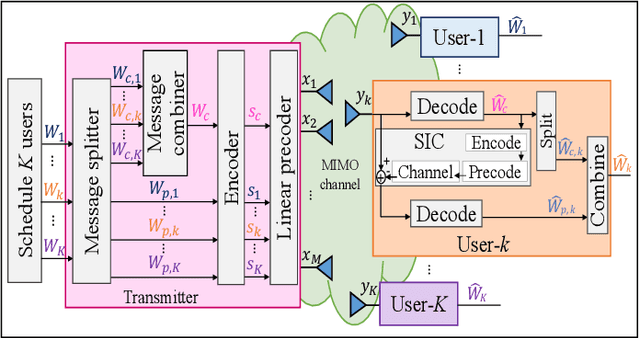
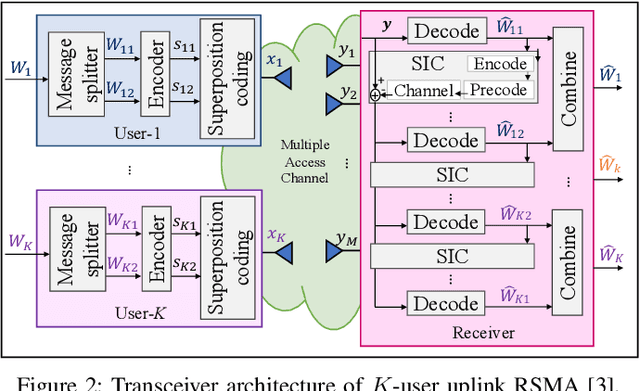
Abstract:This letter is the first part of a three-part tutorial focusing on rate-splitting multiple access (RSMA) for $\mathbf{6}$G. As Part I of the tutorial, the letter presents the basics of RSMA and its applications in light of $\mathbf{6}$G. To begin with, we first delineate the design principle and basic transmission frameworks of downlink and uplink RSMA. We then illustrate the applications of RSMA for addressing the challenges of various potential enabling technologies and use cases, consequently making it a promising next generation multiple access (NGMA) scheme for future networks such as $\mathbf{6}$G and beyond. We briefly discuss the challenges of RSMA and conclude the letter. In continuation of Part I, we will focus on the interplay of RSMA with integrated sensing and communication, and reconfigurable intelligent surfaces, respectively in Part II and Part III of this tutorial.
Rate-Splitting Multiple Access for 6G -- Part II: Interplay with Integrated Sensing and Communications
May 05, 2022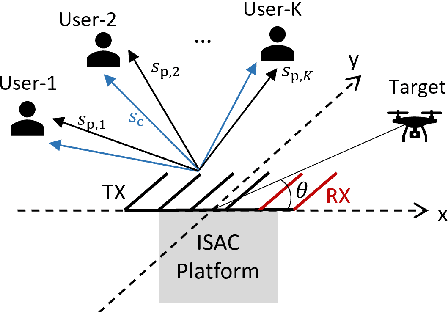
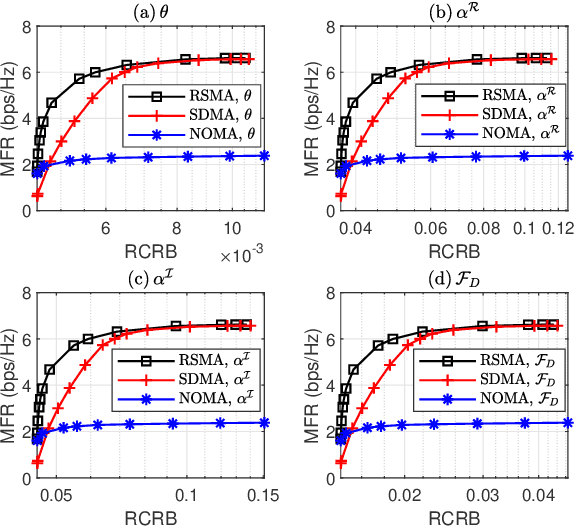
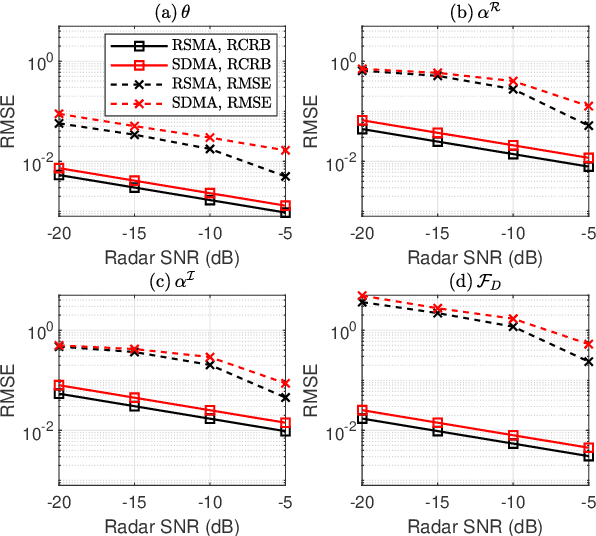
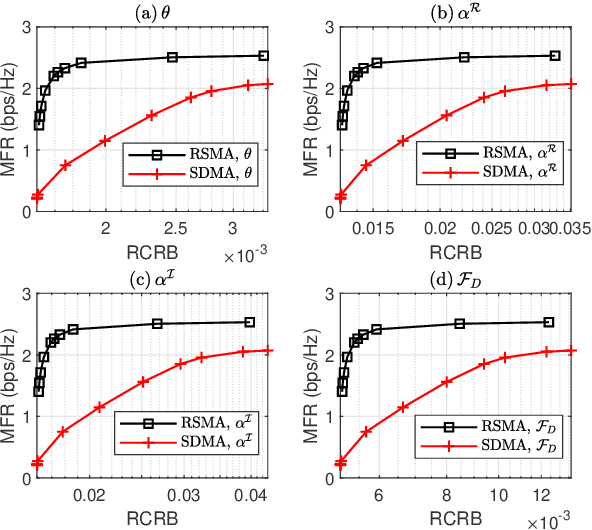
Abstract:This letter is the second part of a three-part tutorial focusing on rate-splitting multiple access (RSMA) for 6G. As Part II of the tutorial, this letter addresses the interplay between RSMA and integrated radar sensing and communications (ISAC). In particular, we introduce a general RSMAassisted ISAC architecture, where the ISAC platform has a dual capability to simultaneously communicate with downlink users and probe detection signals to a moving target. Then, the metrics of radar sensing and communications are respectively introduced, followed by a RSMA-assisted ISAC waveform design example which jointly minimizes the Cramer-Rao bound (CRB) of target estimation and maximizes the minimum fairness rate (MFR) amongst communication users subject to the per-antenna power constraint. The superiority of RSMA-assisted ISAC is verifed through simulation results in both terrestrial and satellite scenarios. RSMA is demonstrated to be a powerful multiple access and interference management strategy for ISAC, and provides a better communication-sensing trade-off compared with the conventional benchmark strategies. Consequently, RSMA is a promising technology for next generation multiple access (NGMA) and future networks such as 6G and beyond.
Rate-Splitting Multiple Access for 6G -- Part III: Interplay with Reconfigurable Intelligent Surfaces
May 04, 2022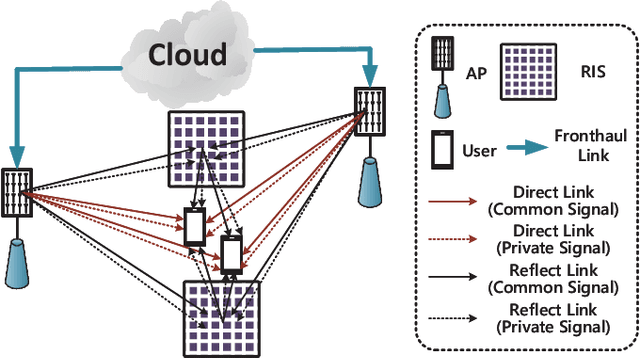
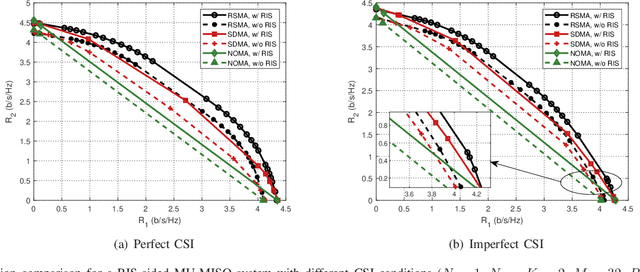
Abstract:This letter is the third part of a three-part tutorial that focuses on rate-splitting multiple access (RSMA) for 6G. As Part III of the tutorial, this letter provides an overview of integrating RSMA and reconfigurable intelligent surface (RIS). We first introduce two potential PHY layer techniques, namely, RSMA and RIS, including the need for integrating RSMA with RIS and how they could help each other. Next, we provide a general model of an RIS-aided RSMA system and summarize some key performance metrics. Then, we discuss the major advantages of RIS-aided RSMA networks, and illustrate the rate region of RIS-aided RSMA for both perfect and imperfect channel conditions. Finally, we summarize the research challenges and open problems for RIS-aided RSMA systems. In conclusion, RSMA is a promising technology for next generation multiple access (NGMA) and future networks such as 6G and beyond.
Model-based Deep Learning Receiver Design for Rate-Splitting Multiple Access
May 02, 2022



Abstract:Effective and adaptive interference management is required in next generation wireless communication systems. To address this challenge, Rate-Splitting Multiple Access (RSMA), relying on multi-antenna rate-splitting (RS) at the transmitter and successive interference cancellation (SIC) at the receivers, has been intensively studied in recent years, albeit mostly under the assumption of perfect Channel State Information at the Receiver (CSIR) and ideal capacity-achieving modulation and coding schemes. To assess its practical performance, benefits, and limits under more realistic conditions, this work proposes a novel design for a practical RSMA receiver based on model-based deep learning (MBDL) methods, which aims to unite the simple structure of the conventional SIC receiver and the robustness and model agnosticism of deep learning techniques. The MBDL receiver is evaluated in terms of uncoded Symbol Error Rate (SER), throughput performance through Link-Level Simulations (LLS), and average training overhead. Also, a comparison with the SIC receiver, with perfect and imperfect CSIR, is given. Results reveal that the MBDL outperforms by a significant margin the SIC receiver with imperfect CSIR, due to its ability to generate on demand non-linear symbol detection boundaries in a pure data-driven manner.
 Add to Chrome
Add to Chrome Add to Firefox
Add to Firefox Add to Edge
Add to Edge